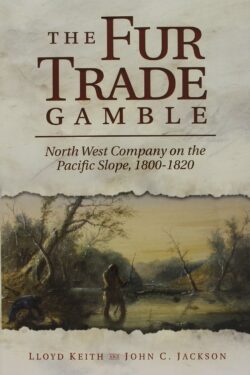#73 North West Company on the Pacific
The Fur Trade Gamble: North West Company on the Pacific Slope, 1800-1820
by Lloyd Keith and John C. Jackson
Pullman, WA: Washington State University Press, 2016
US $27.95 / 9780874223408
Reviewed by Jamie Morton
First published Jan. 15, 2017
*
 Although often addressed over the last two centuries, the story of the early expansion of the land-based fur trade west of the Rocky Mountains continues to present some not-fully-resolved questions.
Although often addressed over the last two centuries, the story of the early expansion of the land-based fur trade west of the Rocky Mountains continues to present some not-fully-resolved questions.
In his introduction to The Fur Trade Gamble, John Jackson notes that the authors’ intent was to more fully recognize the role and impact of the North West Company [NWC] in the process of Euro-North American expansion into and resettlement of the Pacific Slope. Later in the book, this perspective is restated: “For the first two decades of the nineteenth century the history of the Pacific Northwest was the history of the North West Company.”
This focus on NWC activities on the Columbia River was an extension of Lloyd Keith’s earlier work on the company in the Athabasca District, and his considerable research into the wide, but thinly-spread archival records relating to the firm.
Following Dr. Keith’s death in 2008, Mr. Jackson, who had written extensively on the western American fur trade, took over the book project, before passing away himself in 2015.
The combination of Keith’s research and Jackson’s writing has produced a dense but readable narrative dealing with aspects of the NWC venture in the west – the “Columbia Adventure.”

Some new insights are provided by the incorporation of the papers of James Keith, the NWC clerk, and later partner, who managed Fort George, on the lower Columbia. Together with other archival sources, and a close reading of the available published sources, this has made for an enhanced and clarified interpretation of NWC regional development.
The resulting narrative emphasizes the activities of the company on the Columbia River, in the Snake River district, and its attempts to market to the China market. Reference is made to the explorations of Alexander Mackenzie and the trans-montane ventures of Simon Fraser, but the story presented really starts with David Thompson’s activities in the headwaters of the Columbia, and takes off with the NWC competition with, and eventual takeover of, John Jacob Astor’s Pacific Fur Company.
This book also offers a detailed account of the trans-Pacific aspect of the Columbia Adventure, including its maritime fur trade antecedents, the structural challenges inherent in the China trade, and the eventual failure of the company’s attempts to sell North American furs on that market. As well as suggesting that the history of the region in the early nineteenth century was the history of the NWC, Keith and Jackson offer a corrective to the long-entrenched idea that the Columbia Adventure failed due to incompetent NWC managers and extravagant expenditures.

The authors contend instead that it was structural issues, such as the trade monopoly of the East India Company, which made it impossible to develop a viable trade in furs between western North America and China.
The last three chapters of the book examine the human legacy of the NWC, in the form of the freeman, Metis, and Canadian populations associated with the company. Brought to the region as fur providers, many of these people remained in the west, forming families, often in association with local First Nations.
In this section there is also discussion of the impact of the transition from NWC to Hudson’s Bay Company [HBC] systems of production and management. The contention is made that the populations that accompanied the NWC to the region, and their descendants, played a significant role in shaping the subsequent American settler society.
Some of the narrative framing of the book is uneven, perhaps due to the way it evolved, with the passing of both of its authors. Geographically, its title implies that the book would examine overall NWC activity west of the Rockies, but it is focused almost exclusively on the region now in the USA’s Pacific Northwest, together with the trade to China.

The sections dealing with the human legacy of the NWC likewise examine the populations present along the Columbia and involved in the Snake River expeditions.
Organizationally, although the globalized nature of the fur trade is made apparent in the discussion of the Columbia Adventure to China, the overall strategies of the NWC west of the Rockies are given little attention. Company partners and traders worked tirelessly to link the productive New Caledonia district, on the upper Fraser, with the network of posts on the Columbia. A viable brigade system established under the direction of John Stuart permitted cheaper and faster transportation of outfits and returns via the Columbia. Its benefits were not fully realized prior to the 1821 amalgamation of the NWC and HBC. However, together with the rules and practices for fur trade operations developed by Stuart, this provided the blueprint for the successful post-1826 operations of the HBC in the region.

From the British Columbia perspective, more integration of these overall transmontane strategies of the NWC, and more content relating to New Caledonia and other northern trading districts, would have been welcome. However, within the geographic and organizational scope of the book, it provides an effective description and interpretation of the Columbia Adventure of the NWC, its Snake River trapping strategies, and its unsuccessful attempts to market furs on the Chinese market.
The discussion of freeman, country-born, and Canadian participants in the early fur trade provides a solid overview of population dynamics, and the evolution of immigrant and country-born settlement in this period.
The book is well-researched, and well-written; the dense information contained is clearly expressed and easily accessible. It therefore provides an excellent overview of the pre-1821 fur trade era in what is now the Pacific Northwest, and gives a sense of the company strategies, personnel, and outcomes of the Columbia Adventure.
This will become an indispensable resource for students of British Columbia, fur trade, and Pacific Northwest history.
*

Jamie Morton is the Manager of Museum, Heritage & Culture for the City of Port Alberni. Previously he was the Curator of the Hudson’s Bay Company Museum Collection at the Manitoba Museum, and also has been the Curator of Collections at the Oregon Historical Society and the B.C. Forest Museum. For some years, he taught college and university history on Vancouver Island. Prior to that he worked as an historian for Parks Canada, assigned to Western Canadian fur trade history, as well as topics related to the First Nations and industrial history of B.C. He holds a BA in Archaeology from Simon Fraser University, and an MA and a Ph.D in Canadian History from the University of Victoria. Jamie has researched and written on the fur trade to the west of the Rockies, and the impact of commodity-exporting economies on the resettlement and development of western Canada.
*
The Ormsby Review. More Books. More Reviews. More Often.
Publisher and Editor: Richard Mackie
The Ormsby Review is a journal service for in-depth coverage of B.C. books and authors. The Advisory Board consists of Jean Barman, Robin Fisher, Cole Harris, Wade Davis, Hugh Johnston, Patricia Roy, David Stouck, and Graeme Wynn. Scholarly Patron: SFU Graduate Liberal Studies. Honorary Patron: Yosef Wosk. Provincial Government Patron since September 2018: Creative BC
“Only connect.” – E.M. Forster
Comments are closed.